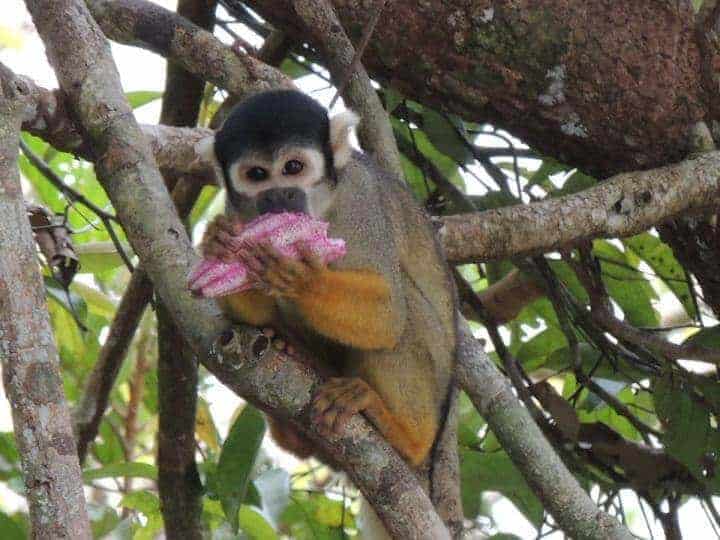Research by UCLA life scientists and 50 colleagues sheds new light on the biological differences among more than 150 species of monkeys in South America, many of which are endangered. Their findings could be particularly important in shaping efforts to conserve the biodiversity of primates in South America.
The scientists have resolved a dispute over whether a small population of black-headed squirrel monkeys (Saimiri vanzolinii), which are found only in an isolated part of Brazil, is a sub-species of another species or its own species.
“We found strong evidence that it’s a distinct, separate species,” said co-author Jessica Lynch Alfaro, an adjunct assistant professor in the department of anthropology in the UCLA College and a member of UCLA’s Institute for Society and Genetics. “It’s its own unique group.”
The scientists, who hail from the U.S. and six other countries, used genetic and statistical analysis to find that this group of monkeys split from its sister group, called Saimiri ustus, about 500,000 years ago, and from a group called Saimiri boliviensis approximately 1.3 million years ago. Researchers previously had thought that Saimiri boliviensis and Saimiri vanzolinii were the same species.
The understanding that Saimiri vanzolinii is its own distinct group is particularly significant because the monkeys’ survival is being threatened by climate change.
“They may lose all of their habitat,” Lynch Alfaro said. “This species has the smallest, most restricted habitat of any Amazonian primate, and it has been predicted that the habitat may be drastically altered due to changes in weather patterns as a result of global warming.”
The monkeys live in a flooded forest in Mamirauá, an extremely isolated part of the Amazon. The area has a predictable seasonal cycle, where the water rises and descends, with average changes of about 35 feet during the course of the year. However, if the rain patterns there shift as climatologists predict, torrential rains and longer-lasting floods could dramatically change the habitat, making it unsuitable for this and other monkey species.
The research was a collaboration among Lynch Alfaro; Michael Alfaro, a UCLA associate professor of ecology and evolutionary biology; and an international team of primatologists. The results are published in 14 papers in a special January issue of the journal Molecular Phylogenetics and Evolution; Alfaro and Lynch Alfaro are senior authors of four of the studies.
“This collection of papers is a major step toward understanding the evolutionary history and biogeographic history that have given rise to the species that we see in South American today, and it will play a key role in identifying conservation priorities for species,” Alfaro said.
One study led by Janet Buckner, a graduate student in Alfaro’s laboratory, solves a long-standing mystery in the evolution of small-bodied tamarin monkeys, which spread throughout the Western Amazon basin in an area larger than California and Texas combined.
Buckner used genetic and statistical analyses to show how these monkeys–part of a group known as marmosets and tamarins–spread across South America. She and colleagues found that small-bodied tamarins and large-bodied tamarins separated geographically and genetically some 9 million years ago, then evolved on their own before coming back into contact with each other approximately 5 million years later. They are much more distinct than scientists realized, she found.
“They are unique and genetically distinct,” Lynch Alfaro said. “Humans are more closely related to chimpanzees than small tamarins are to large tamarins.”
Alfaro said that today’s small tamarins have acquired unique features as a result of 9 million years of unique evolutionary history. To find food, for example, large tamarins stalk and pounce on easily observed insects; small tamarins seek out insects under bark and in tree holes, he said.
The scientists are calling the small-bodied tamarins Leontocebus and reporting that they are a rather diverse group, with significant color variations ranging from white to brown.
Primates have been relatively safe in the Amazon basin, but climate change and the construction of large hydro-electric dams and the rise of enormous soy plantations in the area are taking a toll on primates. About half of the species of monkeys in South America are threatened, said Lynch Alfaro, who has conducted field work in the Amazon and other habitats in South America for 19 years.
The new research has enabled scientists to test the ideas of Alfred Russel Wallace, an early 20th century anthropologist whose life and work are being celebrated at UCLA throughout the academic year. “We’re following in his footsteps,” Alfaro said. “He’s overshadowed by Darwin, but if there were no Darwin, everyone would be talking about Wallace.”
For example, Wallace observed that primates on different sides of large rivers look significantly different and he hypothesized that major rivers that feed the Amazon serve as boundaries that cause diversity.
To test that hypothesis, Alfaro, Lynch Alfaro and colleagues collected and tested tissue samples from monkeys living on both sides of Brazil’s Rio Negro and Rio Branco (which feeds the Rio Negro).
They found that the monkeys were there before the formation of the Rio Negro, which then separated the monkeys from each other and led to the diversification of their features, Lynch Alfaro said.
“They’re distinctly different because the river isolated them on either side when it formed,” she said.
The Rio Branco, meanwhile, served as a stopping point for six different kinds of monkeys, limiting the distribution of uakari monkeys, titi monkeys and gracile capuchin monkeys to the west, and saki monkeys, large tamarins and robust capuchins to the east — and confirming Wallace’s hypothesis.


